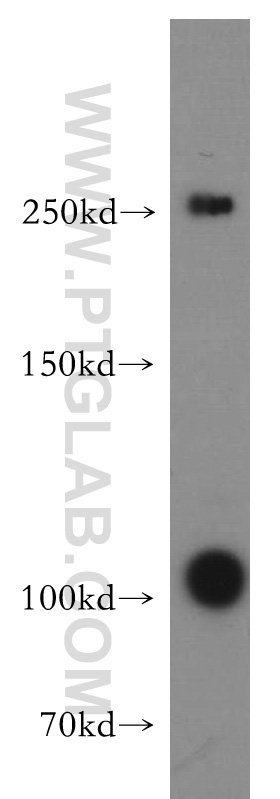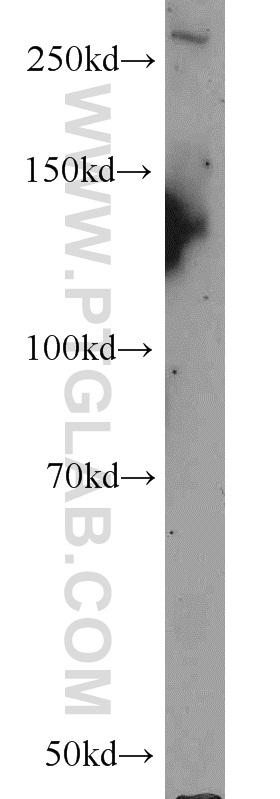验证数据展示
经过测试的应用
| Positive WB detected in | human testis tissue, DU 145 cells |
推荐稀释比
| 应用 | 推荐稀释比 |
|---|---|
| Western Blot (WB) | WB : 1:500-1:1000 |
| It is recommended that this reagent should be titrated in each testing system to obtain optimal results. | |
| Sample-dependent, Check data in validation data gallery. | |
发表文章中的应用
| KD/KO | See 2 publications below |
| WB | See 2 publications below |
| IHC | See 2 publications below |
产品信息
55170-1-AP targets TAF1L in WB, IHC, ELISA applications and shows reactivity with human, mouse samples.
| 经测试应用 | WB, ELISA Application Description |
| 文献引用应用 | WB, IHC |
| 经测试反应性 | human, mouse |
| 文献引用反应性 | human |
| 免疫原 | Peptide 种属同源性预测 |
| 宿主/亚型 | Rabbit / IgG |
| 抗体类别 | Polyclonal |
| 产品类型 | Antibody |
| 全称 | TAF1 RNA polymerase II, TATA box binding protein (TBP)-associated factor, 210kDa-like |
| 别名 | TAF(II)210, TAF1L, TAF2A2, TBP associated factor 1 like, TBP associated factor 210 kDa |
| 计算分子量 | 207 kDa |
| 观测分子量 | 250-260 kDa |
| GenBank蛋白编号 | NM_153809 |
| 基因名称 | TAF1L |
| Gene ID (NCBI) | 138474 |
| RRID | AB_10863289 |
| 偶联类型 | Unconjugated |
| 形式 | Liquid |
| 纯化方式 | Antigen affinity purification |
| UNIPROT ID | Q8IZX4 |
| 储存缓冲液 | PBS with 0.02% sodium azide and 50% glycerol , pH 7.3 |
| 储存条件 | Store at -20°C. Aliquoting is unnecessary for -20oC storage. |
背景介绍
TAF1L, also named as TAF(II)210, belongs to the TAF1 family. It may act as a functional substitute for TAF1/TAFII250 during male meiosis, when sex chromosomes are transcriptionally silenced. The antibody is specific to TAF1L.
实验方案
| Product Specific Protocols | |
|---|---|
| WB protocol for TAF1L antibody 55170-1-AP | Download protocol |
| Standard Protocols | |
|---|---|
| Click here to view our Standard Protocols |
发表文章
| Species | Application | Title |
|---|---|---|
Int J Biol Sci TAF1L promotes development of oral squamous cell carcinoma via decreasing autophagy-dependent apoptosis.
| ||
BMC Gastroenterol Clinicopathological features and prognostic significance of TAF1L in gastric cancer | ||
J Cancer Overexpression of TAF1L Promotes Cell Proliferation, Migration and Invasion in Esophageal Squamous Cell Carcinoma.
|

